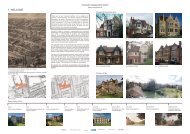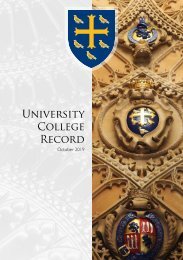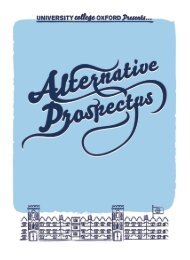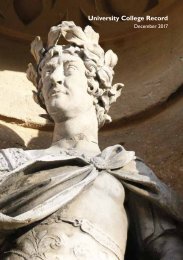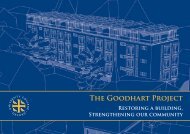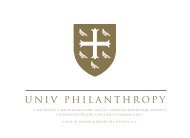Univ Record 2018
University College Oxford Record 2018
University College Oxford Record 2018
Create successful ePaper yourself
Turn your PDF publications into a flip-book with our unique Google optimized e-Paper software.
Honorary Fellows<br />
PROFESSOR STEPHEN WILLIAM HAWKING, (St Alban’s School) died on 14 March<br />
<strong>2018</strong> aged 76. He came up to <strong>Univ</strong> in 1959 to read Physics, and was elected an Honorary<br />
Fellow in 1977. His father Frank also came up to <strong>Univ</strong> in 1923, as did his daughter Lucy<br />
in 1989.<br />
Readers of the <strong>Record</strong> will have read many tributes to Professor Hawking in the<br />
international media, which do justice to his remarkable scientific work, achieved despite<br />
a terrible debilitating illness. Here at <strong>Univ</strong>, we thought that, rather than attempt to sum<br />
up his work once again, we should in this year’s <strong>Record</strong> offer a more intimate tribute, and<br />
remember the Stephen Hawking whom his <strong>Univ</strong> contemporaries knew. We are therefore<br />
very grateful to another <strong>Univ</strong> Physicist who came up in 1959, Gordon Berry, Physics<br />
Professor Emeritus and Director of NISMEC at the <strong>Univ</strong>ersity of Notre Dame, for<br />
writing this memoir of Stephen Hawking as a <strong>Univ</strong> undergraduate (a shorter version of<br />
this tribute appeared in the most recent Martlet):<br />
I first met Stephen Hawking during the final experimental part of the entrance exam<br />
to <strong>Univ</strong>ersity College, Oxford in March 1959. Only students who had done well on the<br />
written part took the experimental part. The experiment involved dropping ball bearings<br />
of different diameters down a long glass tube filled with oil, timing them as a function of<br />
the distance as they fell. I suppose we then graphed the variables to see if the balls obeyed<br />
Stokes’ law. Lots of “Professors” came around inundating two of us with questions: myself<br />
and also a fellow at the next lab table. I later discovered that he was Stephen Hawking.<br />
We met again in College in the autumn at the introductory beer-bash for freshmen –<br />
we were just two of the four entering <strong>Univ</strong>ersity College as physics students. During the<br />
next three years, we shared many experiences: we became tutorial partners, the two of<br />
us meeting weekly with Dr Berman and later Dr Patrick Sandars for Physics, and with<br />
a Dr G. in New College (his name I forget) for Mathematics tutorials; we were both<br />
coxes on the river, almost every weekday afternoon, for the <strong>Univ</strong>ersity College crews;<br />
we assembled together most evenings to play bridge<br />
or poker (pennies and shillings changed hands, and<br />
several bottles of port were consumed), or just went<br />
down to the High Street Inn for darts and drinks<br />
(the “church” where the “prayer books” had handles<br />
on them, according to our college staff).<br />
Two points about the tutorials have significance for<br />
later events: Robert Berman was a thermodynamics<br />
specialist, being the first person to map the interface<br />
of diamond and carbon at very low temperatures<br />
leading to the industrial production of synthetic<br />
diamonds. Steve and I had to cover every detail of<br />
Zemansky’s book Thermodynamics. This knowledge<br />
certainly helped Steve as he later developed his<br />
thermodynamic interpretation of black holes<br />
and his discovery of Hawking Radiation. A good<br />
example (for physics students) of how learning in a<br />
58




